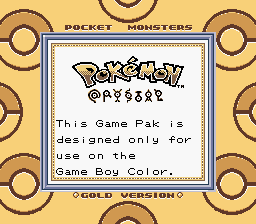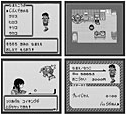Pokémon Crystal beta

|
It has been suggested that this article be moved to Development leftovers of Pokémon Crystal. Please discuss whether or not to move it on its talk page. |

|
This article is incomplete. Please feel free to edit this article to add missing information and complete it. |
Pokémon Crystal introduced many features that have since become staples of the core series games, such as the option to pick a female player character, animated Pokémon sprites and battle facilities with special rules. Likewise, some aspects of the game's initial design did not make it to the final release. However, it has fewer known pre-release elements compared to its companion games, Pokémon Gold and Silver, likely because it is heavily based upon them.
Pre-release
First Mentions
Although Game Freak released a game called Pokémon X for the Nintendo 3DS in 2013, the tentative title for a game similar to the Japanese version of Pokémon Crystal with planned support to connect to a mobile phone and set for an April 2000 release was also Pocket Monsters X (ポケットモンスターX), according to multiple sources such as an Asahi Shimbun news article from December 1999[1] and IGN.[2][3] The game was postponed until 2001 due to the planned release of the Game Boy Advance.[4] The article mentions an adapter for linking a Game Boy to a mobile phone, with the datacenter server used for the feature being hosted by Kyocera in Kyoto.
Early Logo
The Japanese logo shown at Nintendo Space World 2000 was originally similar to the one from Pokémon Gold and Silver.[5] Additionally, the previous referred source also shows an early design for the PokéCom Club rooms.
Pokémon Communication Center
- Main article: Pokémon Communication Center

A picture of the game's development later released by Game Freak revealed an earlier design for the Pokémon Communication Center. Fundamentally, the differences from the final design include an upper floor on the top-left of the map and two machine areas in the main floor instead of just one, one of which was replaced with a Trade Corner for use with the Mobile System GB in the final release.
Female character
A development picture reveals that Kris, the female character introduced in Pokémon Crystal, originally had a different design which was more plain and showed her with black hair in pigtails.[6]
Post-release
Mobile Center Music
An unused song is present in the game's international version. The song would play when players were using their cell phone and the Pokémon Communication Center for wireless mobile battles. This song also appears in Pokémon Stadium 2 when players are watching replays of the mobile battles that they could save and record at the time.
Unobtainable Shiny Pokémon
The coding of Pokémon Gold, Silver, and Crystal have shiny sprites for Mew and all Unown. However, as neither were obtainable normally in Generation II, they are never seen during normal gameplay.
Super Game Boy features

Despite Pokémon Crystal being incompatible with the original Game Boy, Game Boy Pocket, Game Boy Light, the Super Game Boy and the Super Game Boy 2, there is an unused Super Game Boy border programmed into the game, which can be activated by setting a flag in the game's RAM to enable the Super Game Boy features. Cheating devices such as the Game Genie can also be used to achieve the same effect, albeit only temporarily. The border is a leftover from the Japanese version of Pokémon Gold, since the design is the same and the text reads Pocket Monsters Gold Version, rather than Pokémon Gold Version as it does in the English version of Pokémon Gold.[7] This could also suggest that Game Freak used Pokémon Gold as the basis for the development of Pokémon Crystal.
When the player attempts to play the game on a model of the Game Boy prior to the Game Boy Color, the error message "This Game Pak is designed only for use on the Game Boy Color." is output by the game, with the word Crystal spelled out using Unown. There is an unused color palette associated with this message, using an orange tint, which appears when triggering the unused Super Game Boy border; this tint also appears if one force-boots Pokémon Crystal on a Super Game Boy.
References
- ↑ ネット最前線:ニュース
- ↑ IGN: Networking Pokémon (archive)
- ↑ IGN: The Cell Phone, GBA and Pokémon (archive)
- ↑ ポケモン情報サイト「palette」過去ログ38 - ポケパレ!
- ↑ ポケットモンスタークリスタル(仮称)
- ↑ » 入社1年目の思い出:ゲームフリークスタッフボイス
- ↑ Pokémon Crystal - The Cutting Room Floor

|
This game-related article is part of Project Games, a Bulbapedia project that aims to write comprehensive articles on the Pokémon games. |

